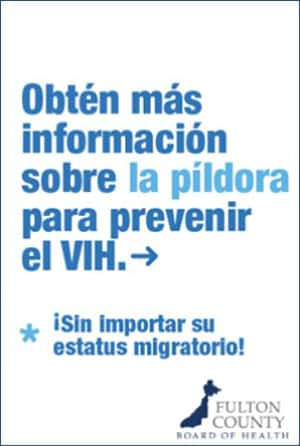CDR Community Spotlight: Atlanta, Georgia

In early 2021, while conducting routine data analysis, state health officials in Atlanta, Georgia, identified several rapidly growing clusters of new HIV diagnoses. Like other Southeastern states, Georgia experiences relatively high HIV rates overall, but these clusters were the first identified that predominantly included young Hispanic and Latino gay and bisexual men.
Without the data analysis, the scale of the growing clusters among this community might have otherwise been difficult to see because the people affected were living in multiple Metro Atlanta counties. Most were in Cobb, DeKalb, Fulton, and Gwinnett Counties—all of which participate in the federal Ending the HIV Epidemic in the U.S. (EHE) initiative.
“It’s not that we were surprised that young gay Hispanic and Latino men in the area were affected by HIV–that’s something we were aware of and working to address,” says Dorian Freeman, clinical infectious disease program director for GNR Public Health, serving Gwinnett, Newton, and Rockdale counties. “We didn’t understand the breadth of need, because we were only seeing our one piece of the puzzle. State data gave us a new urgency to magnify our efforts.”
By the middle of 2022, the clusters included 75 people with recently diagnosed HIV, more than half of whom identified as Hispanic or Latino and 4 in 5 of whom reported being gay or bisexual. The continued growth of the clusters suggested considerable gaps in prevention services for young gay and bisexual men that left them susceptible to HIV infection.
As the clusters grew, state and county health departments needed to identify gaps in the prevention and care structure and develop strategies to close them. They first sought insights from people directly affected by the HIV cluster. They mailed questionnaires to people with HIV whose infections were closely linked in the clusters and Spanish-speaking volunteers called to follow up. They also offered gift cards to encourage people to respond, but very few responded. Experts involved say that language barriers, fear of stigma, concerns about immigration status, and mistrust of government likely discouraged many individuals from sharing information.
Meeting the Community Where They Are
Recognizing the importance of hearing directly from the community before taking other steps, local and state health officials visited service providers, clinics, bars, and nightclubs to ask people about local barriers to HIV prevention. They conducted individual and group interviews with 29 community members and 65 medical and social service providers.
State and county leaders also partnered with local organizations that serve Hispanic and Latino communities.
“Working with the health department changed how we do outreach with communities,” says Eric Rangel, Board President at Latino LinQ, one of the local organizations involved in the response. “We realized we have to instill trust and reassure our communities that we’re here to help, including by meeting people where they are in the places where they’re already comfortable.”

Health officials learned from the community that young gay and bisexual Hispanic or Latino men were often unaware of available HIV prevention tools and services. Language and cultural barriers were common: few area healthcare providers spoke Spanish, and HIV prevention and other health campaigns and materials were almost entirely in English. Many individuals seeking care also didn’t feel comfortable navigating the healthcare system.
Atlanta’s Hispanic and Latino communities also have their own unique needs and values. That meant that simply translating existing English-language materials into Spanish might not be effective. Neither would borrowing Spanish-language approaches and materials that may have been successful in other parts of the United States.
“Most of our Spanish-speaking community around Atlanta is fairly traditional,” says Gilda Pedraza, Executive Director of the Latino Community Fund (LCF) Georgia, another local organization that played a key role in the response. “So, campaigns that work in Los Angeles or New York might not work here. You have to think carefully about who you’re trying to reach and really ground the work in that specific community.”

Community interviews and input from providers also revealed other logistical and personal barriers to HIV care and prevention, ranging from lack of transportation and cost to stigma and mistrust. Identifying these challenges gave health officials the information they needed to design more tailored, convenient, and welcoming services.
Responding to Community Needs
One quick fix was to translate the state’s application form for the federal Ryan White program into Spanish. This program provides HIV care and treatment for people without adequate health insurance. Other solutions included reimagining existing or developing new educational materials and Spanish-language social media campaigns. Health departments specifically designed these to reach Hispanic and Latino communities in the Atlanta metro area.
“Language justice was one of the most important needs we heard from the community,” says Dr. Carlos Saldana of the Fulton County Board of Health. “Talking about HIV and other health conditions can be challenging. Creating culturally relevant materials in Spanish and hiring local community members can help reach more people with the information they need to take control of their health.”
This response also accelerated longer-term efforts to recruit and train health workers who could build stronger understanding and trust with the community. Several Metro Atlanta counties have made concerted efforts to hire more Spanish-speaking staff with rapport in the local communities. Hiring more of these staff members will help provider-client communication, which is critical to helping clients feel safe and welcome.
Guided by these goals and equipped with Ending the HIV Epidemic in the U.S. (EHE) initiative funding, GNR Public Health hired four bilingual health providers and support staff. The new Spanish-speaking employees include a health educator, patient navigator, a community health worker, and a nurse focused on mobile engagement and provider outreach.
“Bridging gaps in service delivery takes trust between healthcare providers and the communities they serve,” says GNR Public Health’s Freeman. “It’s absolutely vital that our staff mirrors the community and deeply understands our clients’ needs. Having a mobile engagement nurse who’s actually in the community has made a tremendous difference.”

Metro Atlanta providers now offer services in convenient locations outside of clinics, including pharmacy-based HIV testing events and pre-exposure prophylaxis (PrEP) referrals at nightclubs. Ultimately, each community’s unique needs inform service locations. Providers are starting to bundle HIV prevention together with other routine health services, such as blood pressure screenings or COVID-19 testing. For example, Ventanillas de Salud, which is operated by LCF Georgia, holds health fairs monthly at Atlanta’s Mexican Consulate which now include culturally relevant information about HIV testing and PrEP. A bilingual community health worker offers HIV testing at an OB/GYN office’s monthly community baby shower.
Building a Collective Response
The cooperation and coordination needed to provide bundled health services and support other metro region-wide efforts quickly became clear. Local health officials say that identifying the HIV clusters highlighted the critical importance of working collectively with the community, with healthcare providers, and with one another. As a result, the response has since grown to embrace community organizations, local service providers, and members of academic institutions who continue to meet regularly.
People engaged in the response also make a point of reaching out to raise awareness of HIV prevention across the affected communities. Some explain the benefits of HIV cluster detection and response to community advisory boards. Others help healthcare providers serving Hispanic and Latino communities better understand how to connect their clients to prevention tools like PrEP.
“Working with local groups and local providers has been fundamental to our response,” says Eleanor Garlow of the Georgia Department of Public Health. “Our Hispanic and Latino community can be hesitant about engaging with government. Building trust is a long-term, multifaceted, and collaborative process that we’re committed to.”
EHE support opened up new avenues for health officials to respond to the clusters. The four EHE counties leveraged and shared federal resources to develop a tailored prevention and care infrastructure benefiting the whole region. For example, the state and CDC created a dashboard to help officials at all levels easily visualize and understand HIV cluster data across the region. Moving forward, trends crossing county lines will be easier to spot and respond to quickly. And these new partnerships and lines of communication also mean that local providers are better able to collaborate and respond swiftly to other emerging health challenges, such as mpox.
“HIV cluster detection and response is complicated, but the key thing to understand is that it can spur action to address issues that might otherwise go unnoticed,” says Fulton County’s Saldana. “I hope our experience in Atlanta will show others that this approach can drive attention and long-term investment in services for a community that had been overlooked.”